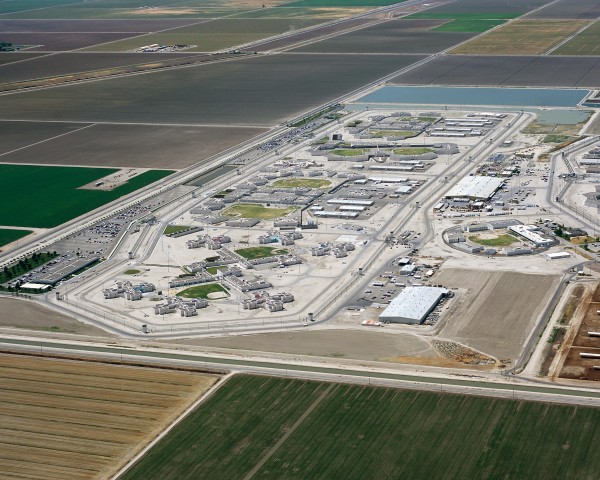
Prison System: California Department of Corrections and Rehabilitation
Status: Active, opened in 1997
Offender Gender: Male
Number of Inmates: 5,357
Security Level: Maximum, Medium, Administrative Segregation
Employees: 1,480. The prisoner: staff ratio is lower than at many similar facilities, in part because the number of employees in non-custodial positions is higher than at many similar institutions.
Distinguishing Feature: The California Substance Abuse Treatment Center and State Prison, Corcoran (SATF) is designed specifically to tackle substance abuse issues in the prison population. Given the number of prisoners in California who are three-strike felon offenders because of underlying substance abuse problems, focusing on treating the addiction can be critical to helping prevent rehabilitation. The prison incorporates a therapeutic treatment model for substance abuse treatment, which has proven successful in smaller prison environments.
The common factor for the inmates at the SATF is substance abuse addiction, but the inmates confined there vary wildly from drug offenders to violent criminals.
When looking purely at prison population, the SATF has been the largest prison in the United States, though its population is currently smaller than the population of Angola in Louisiana. It is a multi-security institution, housing prisoners in medium and maximum security environments, in addition to having a number of prisoners in administrative segregation. The actual living conditions for the inmates depends on the level of security. Inmates in Level II housing live in a medium security environment, with open dormitories surrounded by secure perimeter fencing. Inmates in Level III housing live in a medium/maximum security hybrid; rather than dormitories, they live in cells, surrounded fences, and with armed guards. Inmates in Level IV housing live in a maximum security environment; they live in cells, surrounded by fences or walls, with armed officers inside and outside of the facility.
There are some serious concerns about inmate living conditions in the SATF. A number of inmate deaths in the facility have been linked to a failure to provide adequate medical care to the inmates. In fact, while the purpose of the facility is ostensibly to provide treatment and rehabilitation to inmates, mismanagement has plagued the facility. Therefore, it should come as no surprise that the prison no longer lists rehabilitation as a main goal, but, instead, focuses on keeping inmates in custody until they are to be released.
Although there are concerns about the efficacy of the rehabilitation and substance abuse treatment programs, every prisoner at the SATF must be actively involved in a rehabilitation program. All inmate are required to participate in at least 20 hours of counseling each week. The bulk of the counseling focuses on substance abuse issues, but the counseling also addresses the situational factors that frequently drive addiction, including: life skills, conflict resolution, anger management, and counseling aimed at changing a predilection towards criminal behavior.
Drugs and drug crimes have placed a tremendous burden on the California criminal justice system. A number of offenders are in custody for drug offenses and drug related offenses. Moreover, even offenders who may have been convicted of non-drug offenses, such as property crimes or violent crimes, may have been fueled, at least in part, by substance abuse. Merely incarcerating prisoners is not enough to help rehabilitate them and provide them with the skills to live in the outside world; it is important to help them acquire the tools that they need in order to function in society. Drug and/or alcohol rehabilitation is one way to help addicts acquire those tools, which is why the facility was authorized in 1993. However, from the very beginning the facility experienced several challenges. First, the model was based on much smaller prisons and the success of a therapeutic program does depend, to some degree, on the surrounding atmosphere. With a larger facility, it is more difficult for staff to ensure that no contraband drugs or alcohol come into the facility, which can make it easier for prisoners to access drugs. In addition, the SATF was almost immediately overcrowded. In fact, at one time, the prison actually had more inmates than Angola, which is widely recognized as the largest prison in the United States. Overcrowding at the SATF creates the same psychological stresses as overcrowding at other facilities, which can have a negative impact on efforts towards sobriety.
Ironman star Robert Downey, Jr. is probably the most famous inmate at the SATF; he was there after a parole violation stemming from a drunk-driving conviction. Music producer and convicted murderer Phil Spector spent time at the SATF. It is also home to Cameron Hooker, who is known for kidnapping a victim with his wife and keeping her kept locked in a box under their bed for years.
Inmate Mailing Addresses:
Facility A & B
Inmate Name and Inmate ID
P.O. Box 5248
Corcoran, CA 93212
Facility C
Inmate Name and Inmate ID
P.O. Box 5246
Corcoran, CA 93212
Facility D&E
Inmate Name and Inmate ID
P.O. Box 5242
Corcoran, CA 93212
Facility F&G
Inmate Name and Inmate ID
P.O. Box 5244
Corcoran, CA 93212
Year Built or Opened:
1997
Warden or Supervisor:
Stuart Sherman
Daily Inmate Count:
5,357
Security Level(s):
Maximum
Medium
Administrative Segregation
P.O. Box 7100
Corcoran, CA 93212
Phone Number(s):
559-992-7100
(559) 992-7100
900 Quebec Avenue
Corcoran, CA 93212
Other Prisons in California:
San Quentin State Prison | Wasco State Prison | North Kern State Prison | Folsom State Prison | Correctional Training Facility | California State Prison Corcoran | California Men's Colony | Sierra Conservation Center | Alcatraz Federal Penitentiary | Taft Correctional Institution